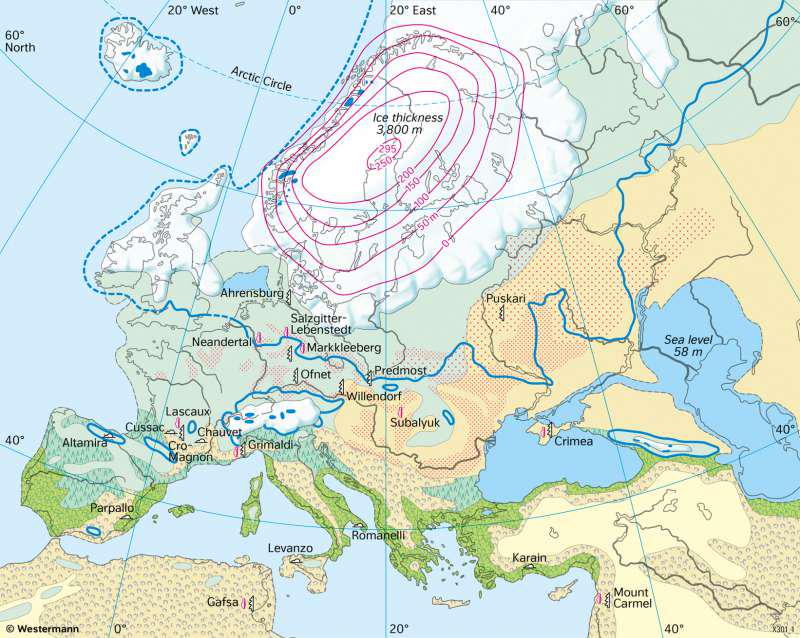Map of Europe 20000 BC


Alex Cartwright
Senior Cartographer & GIS Specialist
Alex Cartwright is a renowned cartographer and geographic information systems specialist with over 15 years of experience in spatial analysis and data...
Geographic Analysis
What This Map Shows
The "Map of Europe 20000 BC" provides a fascinating glimpse into the prehistoric landscape of Europe during the last Ice Age. At this time, much of the continent was covered by ice sheets, drastically altering the geography and climate. The map illustrates the extent of these glaciers, the locations of the tundra, and areas that were more hospitable, possibly supporting early human habitation. It serves as a crucial representation of how ancient environments shaped the movement and lifestyle of early humans.
Deep Dive into Ice Age Europe
The Ice Age, particularly around 20000 BC, was a pivotal period for Europe, marked by the presence of massive ice sheets that extended across much of the continent. These glaciers, primarily the Scandinavian Ice Sheet, covered areas that are now known as the British Isles, Scandinavia, and parts of northern Germany and Poland. Interestingly, the climate during this time was significantly colder than today, leading to the formation of tundra landscapes where only hardiest species could survive.
What’s fascinating is how these ice sheets influenced the geography of Europe. As the glaciers advanced, they carved out valleys and shaped the contours of the land, creating features such as fjords and lakes. Once the ice began to retreat around 12000 BC, it left behind fertile plains and rich valleys, which would eventually become vital for agriculture and settlement in later periods.
The regions that remained ice-free during this time were crucial for human survival. Areas like the Iberian Peninsula, parts of southern France, and the Mediterranean coast offered a more temperate climate with access to resources such as flora and fauna, which would have been essential for early hunter-gatherer societies. Archaeological evidence suggests that humans migrated into these areas, taking advantage of the warmer climate and abundant wildlife.
Moreover, this era saw the emergence of significant megafauna, including mammoths, woolly rhinoceroses, and saber-toothed cats. These large animals not only presented challenges for early humans but also opportunities for hunting and sustenance. The interactions between humans and these creatures would shape early cultural practices and survival strategies, as seen in cave paintings and tools discovered in various sites across Europe.
Regional Analysis
Breaking down the map further, we can observe distinct regional differences in the prehistoric landscape of Europe. In northern regions, the vast expanse of ice dominated the landscape, creating inhospitable conditions for human life. Conversely, southern Europe, particularly the Iberian Peninsula and parts of Italy, provided refuge and resources that supported human populations.
For instance, while Scandinavia and northern Russia were largely uninhabitable due to the thick ice cover, southern France and the Mediterranean coast showed evidence of early human settlements. Sites like Lascaux in France and Altamira in Spain reveal that these areas hosted vibrant communities, with advanced tools and artistic expression emerging as humans adapted to their environment.
Interestingly, the Danube River, though mostly covered by ice, was a vital waterway that would later play a significant role in migration and trade once the ice retreated. The river's valleys provided access to fertile land that attracted early farmers and settlers in subsequent millennia.
Significance and Impact
Understanding the geography of Europe during 20000 BC is more than just an academic exercise; it offers insights into human resilience and adaptability. The harsh conditions of the Ice Age forced early humans to innovate and develop survival strategies that laid the groundwork for future civilizations.
Today, climate change and shifting environmental conditions echo the challenges faced by our ancestors during this time. By studying how early humans adapted to their world, we can gain perspective on our current ecological challenges. Moreover, as we excavate and analyze more sites from this era, we continue to uncover stories that connect us to our distant past, illustrating the continuous relationship between humanity and the environment.
As we reflect on the map of Europe in 20000 BC, it becomes clear that the landscapes we inhabit today have a rich and complex history. Have you ever thought about how the geography around you might have looked thousands of years ago? Each contour, river, and valley tells a part of the story of human survival and adaptation, connecting us to our ancient roots and reminding us of the ever-changing nature of our world.
Visualization Details
- Published
- August 11, 2025
- Views
- 96
Comments
Loading comments...